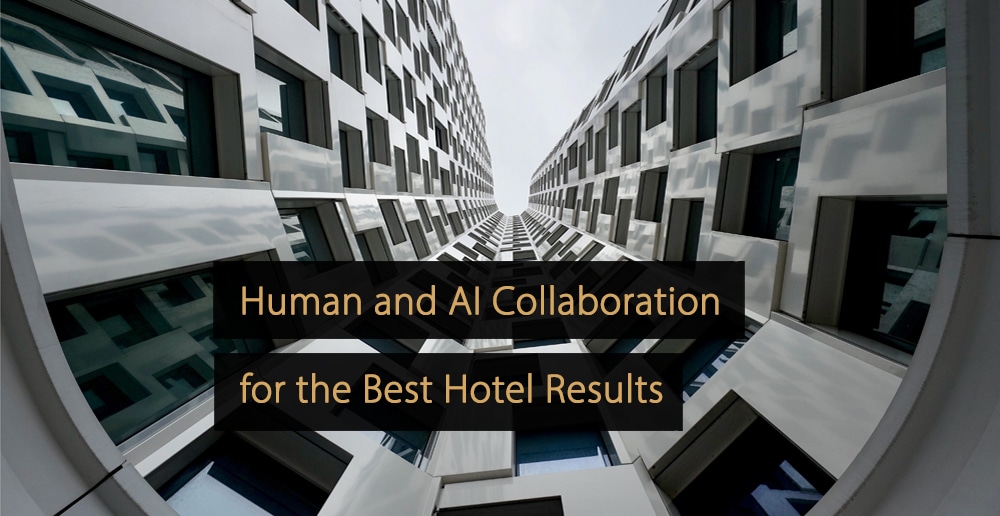The advancement of AI and automation over the past few years has transformed the hospitality industry. New technology enabled gathering and evaluating vast amounts of data, quickly making informed decisions, and lifting the topline.
Especially in the revenue management department, new AI-powered solutions offer the real-time market insights hoteliers need to optimize, adjust and even automate their pricing.
One concern remains: how to guarantee that the system aligns with your hotel’s business strategy? And what part does your team play in this? That’s where the collaboration between humans and machines becomes essential.
Working Together with Artificial Intelligence
Technology advancements have aided revenue managers in streamlining their processes and increasing productivity for decades. The first tools took over tasks like gathering and compiling data. As a result, revenue managers could spend more time on their job’s strategic aspects and less time on the tactical and administrative ones.
Then machine learning and artificial intelligence emerged. They boasted modern pricing algorithms capable of recommending rates or even setting them automatically. This led to the dawn of real-time dynamic pricing. Suddenly hotels were able to exploit as yet unrealized revenue opportunities and increase profitability.
In response to these advancements, one might wonder if it’s time to do away with revenue managers and let the machines take over the department. But even though today’s tools are powerful, this is far from possible.
Consider today’s ships and airplanes, for instance. They all have powerful autopilot features but still, need captains and pilots. These experienced pros are on hand to review the systems regularly, adjust the course if necessary, and handle the numerous other difficult jobs that even the most advanced AI can still not manage.
Solutions for pricing and business intelligence are essential to improve your performance significantly. It’s similar to hotel revenue management. However, some level of human involvement and direction is required if you want the algorithm to adhere to your pricing strategy and brand’s rate hierarchy.
The three following steps will help you create this balance between the revenue manager and their AI-powered aides.
3 Tips for Combining Human-AI Collaboration
Below are three tips for combining Human-AI Collaboration to get the best hotel results.
1. Set the Right Foundation
There’s no doubt about it: AI tools have become excellent at carrying out straightforward tasks. However, they must first understand the task to perform it successfully. For instance, a cargo ship can reach any place with the help of autopilot navigation. But for that to work, it must know the destination port first.
The same goes for hotels. Here, the commercial departments must establish objectives and create a set of strategies that will guide the AI system.
For revenue managers, this means setting revenue targets, determining key client segments, and defining inventory. This includes defining room types, setting standard minimum and maximum rates, and establishing your pricing hierarchy.
Provide this data to your system during set-up and whenever you adjust your strategy. This gives the algorithm the structure it needs to produce sound rate suggestions matching your property, brand, and market.
2. Anticipate Changing Circumstances
The weather rarely stays the same throughout a ship’s voyage. Shifting winds and strong waves can impact sailing speed and may even risk altering the course. Your guidance system must react swiftly and correctly in such circumstances.
Once more, this is also true for revenue management. Here, demand fluctuates frequently, and your RMS must adjust immediately when these unavoidable changes occur. The best systems available today do this by using vast amounts of historical, real-time, and future-facing data to determine their following pricing recommendation. Therefore, regardless of how demand shifts, your rates will always reflect the market’s most recent changes.
You can fine-tune your RMS’ output by feeding it more data. Change your system’s peak and low seasons, for instance, and use past and projected demand information, event schedules, and your expertise to pinpoint these times. They could be significant trade shows, peak travel seasons like winter, summer, or holidays, or even demand fluctuations between weekdays and weekends, which might all be included. Create specific guidelines for these times, so your RMS responds how you want it to during upcoming demand spikes and dips.
3. Adjusting to Special Conditions
Every so often, a ship suddenly finds itself during an unexpected storm. It needs an emergency protocol to get through it all safely in these circumstances. Not only that, though. A crew that can put it into practice and steps in when necessary is also essential.
This is comparable to revenue management, where your hotel will sometimes face unforeseen increases or decreases in demand – that could be a well-known singer canceling a show at the last minute or you attracting a sizable group without much notice. Again, the abundance of data that today’s AI-powered RMS can analyze in seconds allows them to react even to a unique event appropriately. This helps you profit substantially from spikes in demand while avoiding selling out quickly.
However, even the best RMS won’t always be able to handle every situation independently. Your team is critical because they develop, monitor, and modify the rules that guide your system. Prepare backup plans with your revenue department, so they can use them to get your preferred reaction from your system. This could entail rearranging your price hierarchy strategically or seasonally or shifting the rate floor or ceiling for some days. With the ability to quickly change your pricing guidelines, you can maintain your brand’s image, keep your competitive edge, and stay out of the race to the bottom.
Commercial tactics, original ideas, and considering the bigger picture will remain humans’ primary competency areas even as AI’s capabilities advance.
But robust AI-driven solutions will make it easier for revenue managers to perform all these tasks more effectively. That’s where collaboration between people and machines shines.
One thing that will be essential for it to work is the proper method for implementing and operating these systems. This comprises accurately setting parameters, reviewing and modifying them as necessary, and trusting the system, all while knowing when to intervene.
Achieving this balance between human participation and autonomy is crucial, especially since technology keeps advancing rapidly. If you make that work, intelligent automation will ensure you can enjoy smooth sailing regardless of the conditions.
Free Guide: The Ultimate Combination of Tools for Successful Revenue Management
As a revenue manager, you know the two primary constraints in your field: data and time. Data is essential since it enables you to comprehend what is happening in your industry.
In this guide, you’ll learn how technology can improve your decision-making and increase your bottom line by enabling you to obtain higher-quality data quickly.
Click here to download the guide “Increase Your Revenue Management Performance with Hotel Tech”.
More Tips to Grow Your Business
Revfine.com is the leading knowledge platform for the hospitality and travel industry. Professionals use our insights, strategies, and actionable tips to get inspired, optimize revenue, innovate processes, and improve customer experience.Explore expert advice on management, marketing, revenue management, operations, software, and technology in our dedicated Hotel, Hospitality, and Travel & Tourism categories.








Leave A Comment